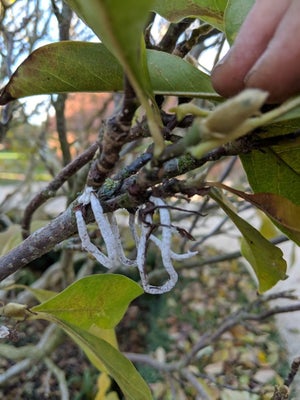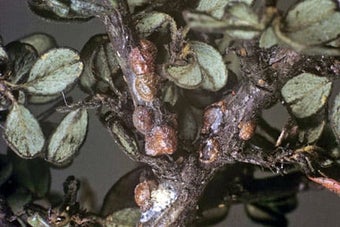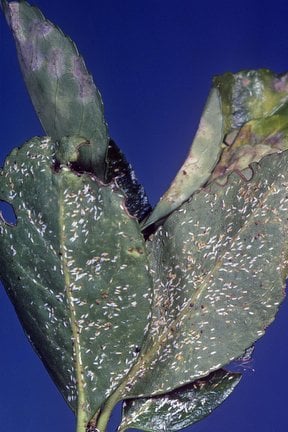
Quick facts
Common name - Cotton stringy scale
Scientific name - Takahashia japonica
Plants affected - Many woody hosts, including Acer, Cornus, Magnolia and Morus.
Main symptoms - Long, white string-like loops of eggs hanging from branches of trees
Most active - Egg sacs appear in the summer, but may stay attached all year
What is cotton stringy scale?
Scale insects are sap sucking true bugs belonging to several families in the Hemiptera. Typically the adults are immobile having a flattened or raised appearance, with no visible legs. They often look like a ‘scale’ on a leaf or stem, many species produce a white wax often covering egg masses. There are more than 100 species found in Britain, 26 of which have been introduced. More than 25 species can be found in gardens or on houseplants.
Cotton stringy scale is native to the east Asia and was first recorded in Northern Italy in May 2017. It can feed on a wide range of woody hosts. The first case in Britain was reported in December 2018 from a Magnolia in West Berkshire, that had likely been imported from Italy. It is not recorded as damaging to plants in its native range or Italy, however, the long stringy egg sacs are very distinctive.
As a non-native, suspect cases should be reported to the relevant plant health authority.
Symptoms
Look out for this distinctive new scale insect:
- Cotton stringy scale produces long, string-like structures that loop around and are attached at either end to the branches of the tree. These structures, called ovisacs, hold the eggs of the insect. They are up to 5 cm long, and made of a tough waxy substance and may remain attached to plants long after the eggs have hatched. The eggs hatch in late spring or early summer
- No other insect in Britain produces similar egg masses
- The adult scale insects are dark brown and oblong, approximately 7 mm long and 4 mm wide
Additional pictures can be seen in the Defra plant health fact sheet.
Management
- Cotton stringy scale is not known to impact the growth and survival of fully grown trees, so its presence can be tolerated
- Encourage predators in the garden, some ladybirds, parasitoid wasps and some birds will eat scale insects
- Adult scales and egg masses can be removed when seen or heavily affected branches can be pruned out at the appropriate time of year for the plant
Biology
Very little is known about the biology of cotton stringy scale but the following has been observed:
- In Italy, there is one generation per year
- Eggs hatch in June, and the nymphs can be dispersed locally on the wind
- The nymphs and young adults are small and unlikely to be spotted until the adults mature and produce egg sacs in the summer months
- Many different woody hosts have been recorded, including those commonly grown in Britain including Acer, Albizia, Alnus, Citrus, Cornus, Cydonia, Juglans, Magnolia, Morus, Parthenocissus, Prunus, Pyrus, Robinia and Salix
- It is possible the known host range of cotton stringy scale will expand as it encounters new plants in Europe


















